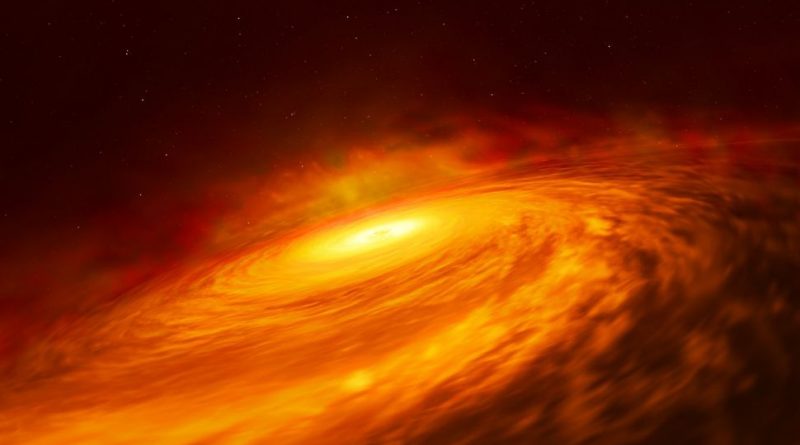How doomed matter reveals the inner secrets of black holes
[ad_1]
Black holes are regions of austere darkness, gobbling up everything — even light — that strays too close. But the environment immediately surrounding a black hole is not so dark. Astronomers often spot copious amounts of light streaming from there, emerging from a thin disk of matter called an accretion disk.
A black hole imprints all of its essential characteristics onto its accretion disk, including its mass, spin, and gravitational field. In the last 10 years, studying the light from such disks has become one of the central methods astronomers use to analyze black holes. And accretion disks supply the only known method for measuring the spin of supermassive black holes, which reside at the center of all large galaxies.
Perhaps the most exotic message sent to us by a black hole’s accretion disk relates to the gravity it feels. In a study published January 22 in The Astrophysical Journal, researchers used X-rays stemming from a black hole’s disk to measure precisely how that black hole’s gravity influences the matter and light nearby. They went on to compare what they found to what they would expect based on Einstein’s well-tested theory of general relativity.
According to general relativity, black holes only have a few major defining features. Two of these are its mass and its spin. (Black holes may also have a third property: electric charge.) These attributes (and these alone) determine the way that the black hole warps space-time around it. And when physicists study the light coming from a black hole’s accretion disk, they gain the ability to effectively “see” the distant invisible object, potentially unveiling these defining characteristics.
Gravity’s whirlpools
“The general picture of the accretion disk is common to many systems,” says Cosimo Bambi of Fudan University in Shanghai, who co-authored the new study. Anything with a significant gravitational field, such as a planet or star, tends to attract matter, which then forms a pancake-shaped ring.
The difference with the accretion disks of black holes is that they are subject to extremely strong gravitational fields. That intense gravity pulls the accreted matter into fast-moving orbits close to the speed of light. And as all this matter scrapes together, unimaginable amounts of friction cause it to heat up to millions of degrees. Those extreme temperatures make the accretion disk glow — not just in optical light, like an oven’s heating element, but with more energetic light as well. Namely, X-rays.
But there’s another catch. When researchers target black holes through their telescopes, they observe so-called “hard X-rays” with 10 to 100 times more energy than expected from collisional heating alone. Physicists have determined that these hard X-rays come from a roughly spherical cloud of extremely hot, billion-degree plasma, called a corona, that encapsulates the black hole. Photons emitted from the accretion disk hit the corona and interact with its high-energy plasma, giving the light even more energy.
These reenergized photons produce remarkable effects on a black hole’ disk. They come from the corona back to the accretion disk, ionizing its atoms and making it fluoresce like a cosmic-scale neon sign. But in this particular case, the atoms emitting the light that astronomers are interested in are iron. These glowing iron atoms produce photons with very particular energies, just as neon signs emit light of a very specific color.
But because the photons have to work their way out of the black hole’s immense gravitational grip, they can lose as much as 80 percent of their energy on their journey. This is known as gravitational redshifting. The photons’ paths are also bent by the black hole’s strong gravity, preventing them from escaping straight out to us. “There are some photons that circle the black hole a few times before they reach the observer,” says Bambi.
So, instead of light with a single wavelength, we observe a broad range of X-rays coming from the accretion disks of black holes, as well as some photons with very specific energies associated with the fluorescence of iron and other elements. By shifting and bending this rich spectrum of colors, even the most mysterious of black holes paints a distinctive picture.
[ad_2]
Original Post


260 thoughts on “How doomed matter reveals the inner secrets of black holes”